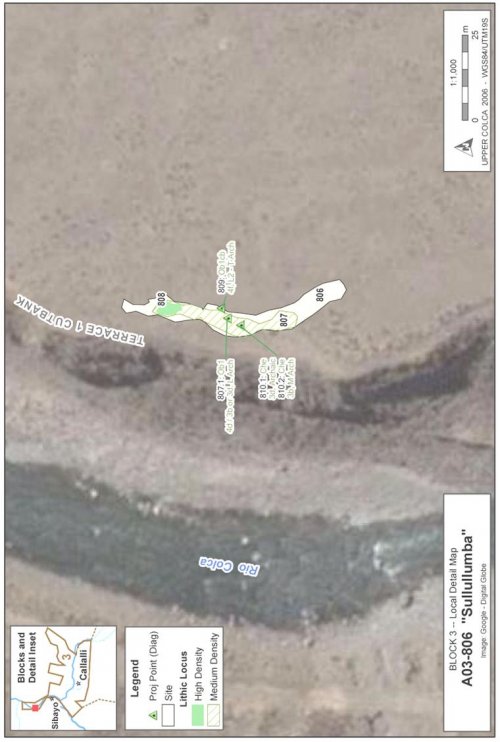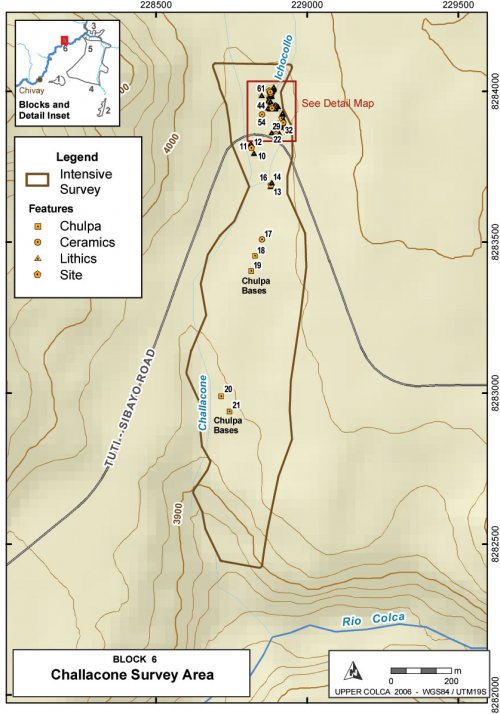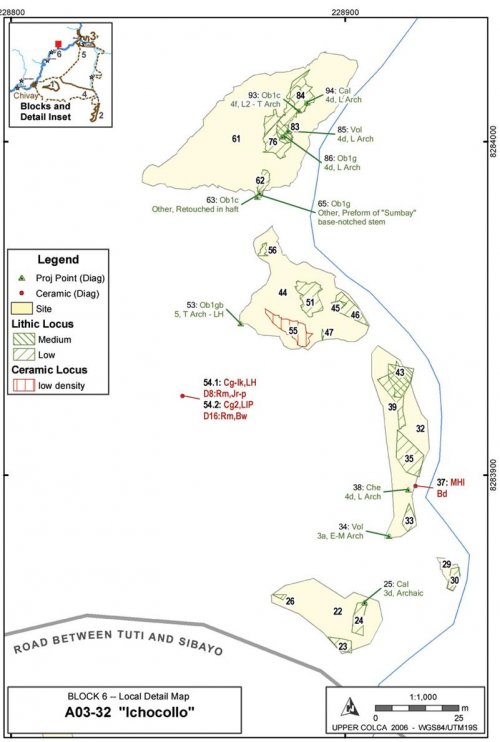Site Type: Chert provisioning site
A final site type category to be considered in this section is that of Archaic Period Block 3 provisioning and initial reduction sites. A relatively large number of sites are found on the lower terraces of major watercourses. The sites can be characterized as exposed, open air sites featuring cortical reduction debris where the majority of material is chert or chalcedony, and the tools are discarded bifacial tools and points. The process appears to have consisted of obtaining chert cobbles from the river bed during low water seasons and opening the cobbles in the riverbed to evaluate the knapping quality of the material. Some percentage of cobbles deemed suitable for further reduction were then transported to the terrace above, where knapping occurred. Sites rich in chert were not exclusively encountered on these river bank areas, but these production sites were abundant in cortical material and the mean flake sizes were relatively large.
These kinds of sites were encountered most frequently on the very edges of terraces but this was perhaps due in part to the greater visibility from erosion along the terrace margins. The sites are otherwise exposed and appear to have been an unlikely place for residential occupation. The profiles of cut banks were investigated at some of these sites and stratified deposits were rarely observed eroding from the cutbanks. The 2003 season survey did not encounter chert raw material in its original geological context, it was only found in the bed of streams in the Block 3 area. As a consequence, it appears that most of the chert artifacts recovered during the 2003 season were probably knapped along these river terrace margins, and it is difficult to assign a time period to these early production sites. There was no strong patterning with the temporally diagnostic point styles and the material types used in Block 3 during the Archaic Foragers period. Points were made from chert and obsidian in Block 3 throughout the Archaic and obsidian points were frequently found on river terrace margins surrounded by chert knapping debris.
A03-806: Sullullumba
A good example of a river terrace provisioning site with evidence of multiple Archaic Period occupations is "Sullullumba" [A03-806]. This site was the only site with purely Archaic occupations in Block 3. It is located up the Colca river from the confluence at Sibayo, and is therefore one of the areas furthest in the study area from the Chivay obsidian source. The site is located on a pronounced terrace edge on the inside bank of a broad bend in the Colca river. Under modern conditions, the area is exposed both to valley winds and by the fact that it lies on the edge of a 40 m steep downslope to the annual high water mark in the river channel.
Figure 6-38. Map of the Sullullumba [A03-806], an Archaic Foragers site showing lithic loci on terrace edge 40m above the annual flood line. Image courtsey of Quickbird DG / Google.
Figure 6-39. Sullullumba [A03-806] along terrace edge above the upper Río Colca. Yellow notebook and scale bar are visible in the center-rear of photo.
|
ArchID |
SiteID |
FileType |
Description |
Area (m2) |
|
806 |
806 |
Site_a |
Sullullumba |
366.6 |
|
807 |
806 |
Lithic_a |
Medium Dens, 10 Obs |
169.6 |
|
808 |
806 |
Lithic_a |
High Dens, 10 Obs |
21.3 |
Table 6-43. Loci at Sullullumba [A03-806].
Artifact analysis from Sullullumba
As one of the only single component Archaic Forager sites, seventy-four artifacts collections from this site were given thorough attention in lab analysis. The items below indicate the kind of lithic reduction that occurred on river terraces some distance from the Chivay source.
Obsidian
Obsidian material consisted of two types: clear and clear-banded flakes with no heterogeneities, and grey and black shaded obsidian with heterogeneities. Two broken projectile points and one broken biface were made from obsidian that is presumably of Chivay type material. A single flake of clear obsidian was found highly rotated and with 20% dorsal cortex, placing it at a mid-stage reduction. This obsidian flake was perhaps struck from the biface or the projectile point collected from this site.
Chert and Chalcedony
No pattern was discerned in the color of chert used at Sullullumba, but there was a relatively high percentage of chert and chalcedony in the surface assemblage. From the collection of 74 artifacts from the site, 50% were made of chert or chalcedony. Sixty-five percent of the chert showed signs of heat treating. Interestingly, about half of the chert flakes showed signs of rotation indicating that the potential of chert cores was maximized despite the probable availability of chert in the Colca river. None of the flakes, however, were bifacial thinning flakes and only six flakes had more than 20% cortex. No correlation was noted between (1) the flakes with high rotation index and (2) heat treatment or chert color. Thus, it appears that chert was being procured and preforms were being produced but the final, thinning stages of point production were not occurring at this site or these smaller flakes were not recovered from the surface context.
A number of interesting projectile points were collected here that include a type 4f (Terminal Archaic) point made from clear banded Ob1 obsidian that includes pressure flaking around the haft Figure 6-40. Another point is a likely type 3b (Middle Archaic) point made from red chert with several spines on the haft margin.
Figure 6-40. Projectile points from Sullullumba [A03-806]. These include (a) an obsidian Ob1 4F (Terminal Archaic) point [A03-809.1] and (b) and the base of a probable 3b (Middle Archaic) chert point with shoulder spines [A03-810.2].
Figure 6-41. The high density lithic locus A03-808 consisted of aphanytic volcanics and chert.
Complete flakes from this site show highly variable attributes that result from a complete reduction sequence having occurred in the area. A high density locus of flakes made of fine-grained volcanics, chert flakes, and chert heat-shatter [A03-808] perhaps result from a single knapping event. In sum, this site presents evidence of Archaic Period open-air activities a greater distance away from the influence of the Chivay source.
A03-32 "Ichocollo" site cluster in Block 6
Approximately 10 km down stream from Block 3 a cluster of open-air sites along a tributary to the Colca was encountered in a smaller survey area called block 6. This block contains a large fraction of diagnostic Archaic projectile points along with ceramics and projectile points dating to the later Prehispanic period. In the modern geography of the region Block 6 lies immediately above the portion of the Colca valley with intensive agriculture. The Río Challacone descends from the north-east flanks of the glaciated Nevado Mismi (5556 masl) on the north side of the Colca valley, while the Ichocollo drains the south side of Cerro Chungara (5286 masl), a peak that was probably glaciated on its southern flank approximately in the same period of time as the Chivay obsidian source area contained glaciers.
|
SiteID |
FileType |
Description |
Area (m2) |
|
22 |
Site_a |
"Ichocollo 3" |
400.1 |
|
29 |
Site_a |
"Ichocollo 4" |
36.4 |
|
32 |
Site_a |
"Ichocollo 5" |
527.5 |
|
44 |
Site_a |
"Ichocollo 6" |
729.9 |
|
61 |
Site_a |
"Ichocollo 7" |
1375.5 |
Table 6-44. Site sizes in Ichocollo [A03-32].
This glaciation may have provided steady water to residents along the eastern tributary stream named Ichocollo. Today, the western of the two, the Challacone drainage, appears to be the larger stream channel and is more scoured out (see geology map in Figure 4-15), a feature perhaps related to the geologically recent large mudslide visible in the geology map as "Ladera Tinday" with the Qr-desymbology.
Figure 6-42. Block 6 Challacone - Ichocollo overview map
Figure 6-43. Ichocollo complex along Quebrada Ichocollo.
Artifacts from Ichocollo complex
Several clusters of lithics and ceramics were identified and divided into sites in this confluence area between the two drainages. The greatest density of artifacts were found on the west bank of Quebrada Ichocollo between the two streams, in an area that is relatively low lying compared to other creek banks in the zone. The area was occupied in numerous episodes in prehistory, as is evident in the diagnostic artifacts that belong to styles spanning all time periods from the Early Archaic to the Inka period. There are a number of environmental characteristics that would suggest that this area would be reused frequently in prehistory. On a local scale, the position of these sites between the two creeks perhaps provided the residents with greater opportunities in both water sources and in lithic raw materials, as cobbles occur in the creek beds. In terms of the position of this survey block in the valley, as was noted previously, the Challacone drainage is at nearly 4000 masl but it is geographically only 3 km to the east of Tuti zone that includes the warmer reaches of the Colca valley below 3900 masl and the beginning of intensive agriculture in modern landuse patterns.
A number of chert and chalcedony nodules were observed in the Ichocollo streambed and the chert was predominantly red in color and was a consistent, homogeneous material with moderately good fracture characteristics. The predominantly red-orange chert nodules in the river are evident in material used for the bifacially flaked lithics found in this site cluster, and 30 of these bifacial tools showed signs of heat treating. Relatively few of the artifacts of any material type, including chert, contained exposed cortex. One chert core had 3 rotations, and chert flakes were predominantly in advanced stages of reduction. Obsidian was of both grey and clear varieties and 27% of the obsidian in the collections had heterogeneities.
Figure 6-44. Photo looking northwest across Ichocollo creek in the foreground, the site cluster that includes "Ichocollo" [A03-32], and Challacone creek below the structure in the background.
|
Biface |
Retouched Flake |
Proj Pt |
Core |
Total |
|
|
Obsidian |
14 |
2 |
5 |
21 |
|
|
Volcanics |
3 |
1 |
2 |
6 |
|
|
Chalcedony |
1 |
1 |
3 |
5 |
|
|
Chert |
10 |
5 |
1 |
1 |
17 |
|
Quartzite |
3 |
3 |
|||
|
Total |
31 |
9 |
11 |
1 |
53 |
Table 6-45. Bifacially Flaked Lithics from Ichocollo by Material Type
|
Length (mm) |
Total |
||||||||
|
15-20 |
20-25 |
25-30 |
30-35 |
35-40 |
40-45 |
45-50 |
>50 |
||
|
Obsidian |
4 |
8 |
3 |
3 |
1 |
1 |
20 |
||
|
Volcanics |
1 |
1 |
1 |
3 |
|||||
|
Chalcedony |
1 |
2 |
1 |
1 |
5 |
||||
|
Chert |
1 |
1 |
3 |
3 |
2 |
5 |
15 |
||
|
Quartzite |
2 |
1 |
3 |
||||||
|
Total |
4 |
10 |
5 |
6 |
4 |
7 |
4 |
6 |
46 |
Table 6-46. Bifacial Lithics at Ichocollo showing Counts of Material Types by Length
An examination of lengths of bifacially-flaked artifacts from the Ichocollo area by material type shows that the immediately-available chert and chalcedony materials are found in bifaces in a range of sizes. Together with the lack of high rates of cortex, these data suggest that the Ichocollo site cluster is associated predominantly with middle-stage reduction. Potentially, decortication occurred in or near the stream bed, while middle and more advanced reduction occurred closer to the residential sites.







